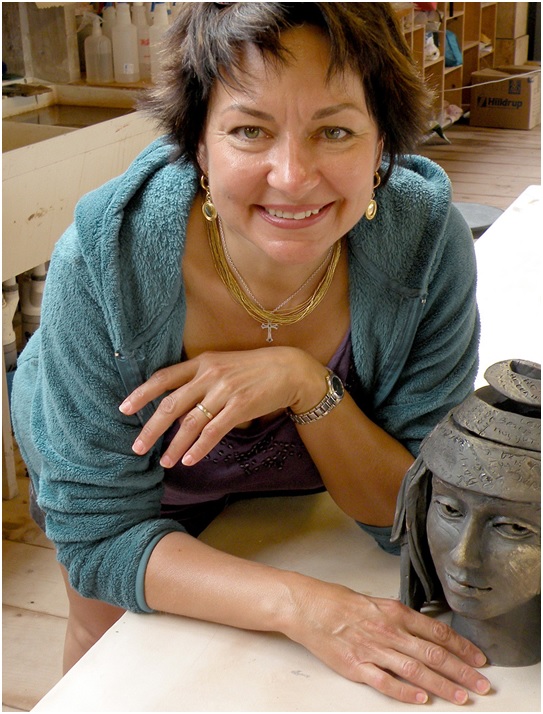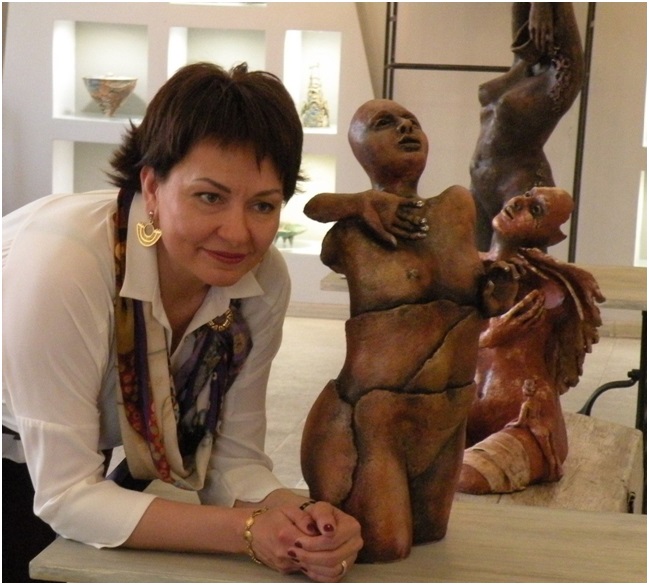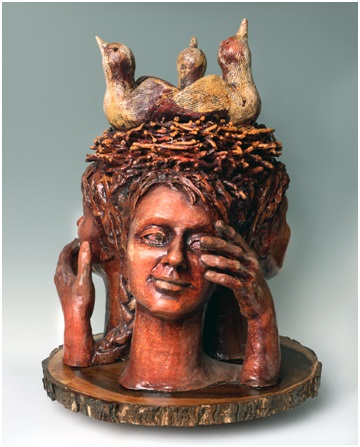
– Good afternoon, Vera. First, please tell us about your work.
During the years that I traveled and lived in Latin America, I realized that I like ceramics and sculpture. Moving to the States, a new country where no one knows you, in adulthood is not easy; anyone who has experienced it, I think, will agree with me. On the advice of a French immigrant friend, I rented a studio in the famous artist spot Canopy, not because I needed space to work but to blend in with colleagues and collectors. ” Canopy” in Austin is where artists of the city have been gathering for many years, creating art, putting their work up for sale, and participating in East Open Studios. That in itself is a big event in the life of the city. Artists open their studios for three days a year to visitors and sell their work directly to collectors. This event attracts thousands of visitors. I remember that before Open Studios, I had to urgently open a business bank account to transfer money from sales of works there. This is how Vera Smiley Ceramic Art Studio was born. When I studied at Almaty University, we were not trained to run a business but were taught to be professional artists. But if you’re an artist in the States and want to be successful, you need to learn how to be a businessman.
I remember when a couple of young people, formally dressed, came into my studio and asked for my license to sell my work. My heart pounded, and my fertile imagination immediately transferred me to “jail.” But nothing terrible happened; the young people, representatives of the tax office, were amiable. I explained that this was the first time I had put my work up for sale and did not even fully hope for success. However, they assured me of the need to fill out all forms for obtaining a taxpayer license and paying sales taxes. Success came immediately. In the very first year, I managed to declare myself, sell several of my sculptures, become a member of the Union of Texas Sculptors, and even enter their board of directors. With other aspiring artists from Canopy, we formed the group “Artist 916”, with whom we hold periodic exhibitions in Austin and beyond, exchange information, and grow professionally. Thus began my career as an immigrant artist in America. To this day, you have to learn a lot, how to run a business, express yourself, participate in exhibitions, and work with collectors. There is a lot of accessible material on the Internet.
Fortunately, we live in a time when learning and improving is not a problem, you just need to have a desire. Once, when I was presented at the exhibition of the union of sculptors, they said about me that I was a “well-received new artist in Austin.” I liked this phrase, but I immediately remembered how much work was behind it. To be “well-received” in a new place, you need to go out of your way to be one of the best in your field and be memorable and persistent in achieving your goals. Although, of course, there were many failures in exhibitions and disappointments but, I am very pleased with my new career. In 4 years I received several prizes for my sculptures and won first place at exhibitions, which is always pleasant and encourages me to move forward.
– Where did you live before, and how did you get to Austin?
I spent the first third of my life in Almaty, Kazakhstan. There I met my husband, with a cigar in his mouth, a plaid shirt, and blue jeans. It was a club with live rock music, and when “Hotel California” came on, he invited me to dance and whispered that California was the place where he was born. And it seemed to me that our meeting was just a game of chance, an unreal story from soap operas. By that time, I was an accomplished artist in Kazakhstan. I liked my life, but the prospect of seeing the world and starting a new life with the man I loved seemed a very tempting challenge. Tests are always interesting. We got married in Almaty and went to live in Latin America. My husband managed engineering projects worldwide, and we moved every three years from country to country. When somebody asked me who I am and where I was from, I answered that I was Russian, never lived in Russia, a citizen of America, although I had never lived there either, and I came from Kazakhstan.
Somehow, while making plans for our life, my husband and I decided to drive around America and choose a place for our future home. We looked at houses in the San Francisco area, Seattle, Denver, and Dallas. After studying our tastes for three days, a realtor from Dallas advised us to stop by Austin and said that we would like Lakeway. So we did. And when we learned about this Texas oasis better, we bought a house here with the opportunity for me to have an art studio. But we continued to live abroad until the husband retired. It happened four years ago, and now I can fully devote myself to my favorite art again.

– What do you like most about Austin?
I guess I like what the locals like least about Austin! Austin is growing and changing. It appeals to me very much, the idea of growing together. When I came to Austin for the first time ten years ago, as if to explore, this city was a little different, calmer, but even then, I felt the air of change. My American friends who visited Austin always spoke very well of it. And the fact that ambitious people from all over the country come here prophesies a great future gives me confidence that art in this city will develop and become more and more in demand every year.
– How do you participate in the life of the Russian-speaking community?
I am pleased that the Russian community in Austin is becoming more active. I love to watch the growing popularity of the Russian School, and I hope that in time I will find an opportunity and demand for teaching ceramics there. I also plan to open my art studio for students, hoping that my compatriots will find the time and means to touch the art. I heard that there is a Russian gallery in Houston. I hope that enthusiasts will appear here to open something similar. I would very much like to participate in the realization of this idea.

– What event in the life of the commune in recent years has pleased you the most?
It is difficult for me to answer this question because, to my regret, during my 4-year stay here, I did not participate in the commune’s life. However, I have many Russian acquaintances, fans of my work, and friends here in Austin. I am sincerely glad to see how my compatriots successfully implement their business ideas, and I hope that there will be more of them. All this gives me hope that our Russian commune will be more active and fruitful.
– What do you do and enjoy besides art?
It is hard to find other hobbies when you already have a favorite thing – ceramics and sculpture. It takes up all my time. I have pretty big plans for the development of my favorite business. I try to be physically active, and I learn to cook healthy food. I love my family and my dog. I love meeting friends and exchanging stories, books, and immigrant life experiences. I am glad that are many parks around, in almost all areas of the city are places to walk and enjoy the beauty of nature.

– How can the Russian speakers of Austin support you?
I think that we all can and should support each other. I would like to see more compatriots who come to art exhibitions and are interested in sculpture. I understand that it is not always time for this. Everyone has to work hard to stay afloat and support their families. But I hope that the Russian-speaking of Austin will be able to find more time and desire to enjoy art and spiritual growth over time.
– What do you dream about for Russian-speaking in Austin in the future?
I dream that the Russian commune will grow and develop. I believe in the Russian school and maintaining Russian traditions away from the Motherland. I see a lot of good posts on Russian FB, where people try to help with advice and find time to answer the questions of newly moved compatriots. I also dream that we all find time not only for our children and peers but also for our elderly compatriots. So many people here have elderly parents who do not know what to do. They miss their homes; many do not speak English and feel uncomfortable. I would like to see a group where our oldest generation could spend time in friendly communication.

– What would you like Americans to learn about Russian culture, traditions, and holidays?
As a person of art, I would like to see more respect for Russian art in America. When my son was studying at a local university, and I leafed through his textbook on art history, I was disappointed to find that only a couple of pages were devoted to Russian art. Unfortunately, Russia is by and large known here for applied arts, nesting dolls, Khokhloma, etc. As an artist, I am very proud of the diversity and richness of Russian art, especially fine arts, sculpture, and architecture. But in America, few people know that in Russia, there have been, and there are, brilliant artists and their contributions to world art. It seems that knowledge of the cultures of the peoples of the world could enrich the inner world and understanding of art. It always brings people together and helps us understand and accept each other.
Contact information:
Vera Smiley
Website: https://www.artsvera.com/
